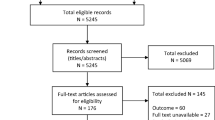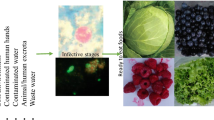Abstract
Purpose
This review analysed outbreaks of human cryptosporidiosis due to raw milk. The objective of our study was to highlight and identify underestimated and underreported aspects of transmission of the parasite as well as the added value of genotyping Cryptosporidium isolates.
Methods
We conducted a descriptive literature review using the digital archives Pubmed and Embase. All original papers and case reports referring to outbreaks of Cryptosporidium due to unpasteurized milk were reviewed. The cross-references from these publications were also included.
Results
Outbreaks have been described in the USA, Australia, and the UK. Laboratory evidence of Cryptosporidium from milk specimens was lacking in the majority of the investigations. However, in most recent reports molecular tests on stool specimens along with epidemiological data supported that the infection was acquired through the consumption of unpasteurized milk. As the incubation period for Cryptosporidium is relatively long (days to weeks) compared with many other foodborne pathogens (hours to days), these reports often lack microbiological confirmation because, by the time the outbreak was identified, the possibly contaminated milk was not available anymore.
Conclusion
Cryptosporidiosis is generally considered a waterborne intestinal infection, but several reports on foodborne transmission (including through raw milk) have been reported in the literature. Calves are frequently infected with Cryptosporidium spp., which does not multiply in milk. However, Cryptosporidium oocysts can survive if pasteurization fails. Thus, pasteurization is essential to inactivate oocysts. Although cryptosporidiosis cases acquired from raw milk are seldom reported, the risk should not be underestimated and Cryptosporidium should be considered as a potential agent of contamination. Genotyping Cryptosporidium isolates might be a supportive tool to strengthen epidemiologic evidence as well as to estimate the burden of the disease.

Similar content being viewed by others
References
Cacciò SM, Chalmers RM. Human cryptosporidiosis in Europe. Clin Microbiol Infect. 2016;22:471–80.
Chalmers RM, Giles M. Zoonotic cryptosporidiosis in the UK—challenges for control. J Appl Microbiol. 2010;109:1487–97.
Casemore DP. Epidemiological aspects of human cryptosporidiosis. Epidemiol Infect. 1990;104:1–28.
Lima AA, Samie A, Guerrant RL. Cryptosporidiosis. In: Guerrant RL, Walker DH, Weller PF, editors. Tropical infectious diseases. Philadelphia: Elsevier-Churchill Livingstone; 2011. p. 640–663.
Chen XM, et al. Cryptosporidiosis. N Engl J Med. 2002;346:1723–31.
Bouzid M, et al. Risk factors for Cryptosporidium infection in low and middle income countries: a systematic review and meta-analysis. PLoS Negl Trop Dis. 2018;12:e0006553.
Rehn M, et al. Post-infection symptoms following two large waterborne outbreaks of Cryptosporidium hominis in Northern Sweden, 2010–2011. BMC Public Health. 2015;15:529.
Widerström M, et al. Large outbreak of Cryptosporidium hominis infection transmitted through the public water supply. Sweden Emerg Infect Dis. 2014;20:581–9.
Robertson LJ, Chalmers RM. Foodborne cryptosporidiosis: is there really more in Nordic countries? Trends Parasitol. 2013;29:3–9.
Mota A, et al. Risk assessment of cryptosporidium and giardia in water irrigating fresh produce in Mexico. J Food Prot. 2009;72:2184–8.
Yoshida H, et al. An outbreak of cryptosporidiosis suspected to be related to contaminated food, October 2006, Sakai City, Japan. Jpn J Infect Dis. 2007;60:405–7.
Quiroz ES, et al. An outbreak of cryptosporidiosis linked to a foodhandler. J Infect Dis. 2000;181:695–700.
Hamnes IS, et al. Prevalence of giardia and cryptosporidium in dairy calves in three areas of Norway. Vet Parasitol. 2006;140:204–16.
Hasan MH, et al. Detection of Cryptosporidium oocysts in ovine and caprine raw milk in relation to rearing management. Assiut Vet Med J. 2018;64:47–50.
Harp JA, et al. Effect of pasteurization on infectivity of Cryptosporidium parvum oocysts in water and milk. Appl Environ Microbiol. 1996;62:2866–8.
Boor KJ, et al. A 100-year review: microbiology and safety of milk handling. J Dairy Sci. 2017;100:9933–51.
Doman B et al. Cryptosporidium outbreak associated with the consumption of unpasteurized cow milk, New Mexico. 2017. https://cste.confex.com/cste/2017/webprogram/Paper8610.html. Accessed 27 Nov 2019.
Rosenthal M, et al. Centers for Disease Control and Prevention (CDC). Notes from the field: cryptosporidiosis associated with consumption of unpasteurized goat milk, Idaho, 2014. MMWR Morb Mortal Weekly Rep. 2015;64:194–5.
Harper CM, et al. Outbreak of Cryptosporidium linked to drinking unpasteurised milk. Commun Dis Intell Q Rep. 2002;26:449–50.
Gelletlie R, et al. Cryptosporidiosis associated with school milk. Lancet. 1997;350:1005–6.
Djuretic T, et al. General outbreaks of infectious intestinal disease associated with milk and dairy products in England and Wales: 1992–1996. Commun Dis Rep CDR Rev. 1997;7:R41–45.
Soave R, et al. Cryptosporidiosis in a rural community in central Mexico. J Infect Dis. 1989;159:1160–2.
Freidank H, Kist M. Cryptosporidia in immunocompetent patients with gastroenteritis. Eur J Clin Microbiol. 1987;6:56–9.
Badoui L, et al. Intestinal cryptosporidiosis in HIV-infected patients in the department of infectious diseases. BMC Infect Dis. 2014;14:P52.
Dumant AC, et al. Clinical and epidemiological characteristics of Cryptosporidium spp. infections in paediatric patients in France, 2015–2017. J Pediatr Gastroenterol Nutr. 2018;66:486.
European Centre for Disease Prevention and Control. Annual epidemiological report for 2016—Cryptosporidiosis. Stockholm: ECDC; 2018.
Chalmers RM, Cacciò S. Towards a consensus on genotyping schemes for surveillance and outbreak investigations of Cryptosporidium, Berlin, June 2016. EuroSurveill. 2016;21:30338.
Laberge I, et al. Detection of Cryptosporidium parvum in raw milk by PCR and oligonucleotide probe hybridization. Appl Environ Microbiol. 1996;62:3259–64.
Food and Agriculture Organization of the United Nations, FAO (1990) The technology of traditional milk products in developing countries. https://canadianpreppersnetwork.com/cd3wd/disk5/_ag_milk_products_tradit_unfao_en_lp_112630_.pdf. Accessed 28 Nov 2019.
Jittapalapong S, et al. Prevalence of Cryptosporidium among dairy cows in Thailand. Ann N Y Acad Sci. 2006;1081:328–35.
Acknowledgements
This work was funded by the Italian Ministry of Health “Fondi Ricerca Corrente–Linea 3, progetto 8", to IRCCS Sacro Cuore Don Calabria Hospital.
Author information
Authors and Affiliations
Corresponding author
Ethics declarations
Conflict of interest
The authors declare that they have no competing interests.
Rights and permissions
About this article
Cite this article
Ursini, T., Moro, L., Requena-Méndez, A. et al. A review of outbreaks of cryptosporidiosis due to unpasteurized milk. Infection 48, 659–663 (2020). https://doi.org/10.1007/s15010-020-01426-3
Received:
Accepted:
Published:
Issue Date:
DOI: https://doi.org/10.1007/s15010-020-01426-3




